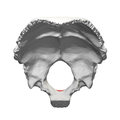Foramen magnum
The foramen magnum (Latin for "great hole") is a large oval-shaped opening located in the base of the occipital bone. It represents a vital anatomical structure as it allows for the passage of the spinal cord from the brainstem to the spinal column. Notably, it is the largest foramen in the skull.
Anatomy[edit]
- Location: Situated centrally at the base of the skull, bordered anteriorly by the basiocciput, posteriorly by the supraoccipital, and laterally by the exoccipitals.
- Size and Shape: Oval in outline, its longest diameter is anteroposterior, with variations in its dimensions among individuals.
- Structures Passing Through: The foramen magnum transmits various important structures:
- The lower part of the medulla oblongata, which continues as the spinal cord.
- The vertebral arteries, which ascend to supply the brain.
- The anterior and posterior spinal arteries.
- The meningeal branches of the vertebral arteries.
- The spinal accessory nerve (cranial nerve XI).
Clinical Significance[edit]
- Trauma: Fractures involving the foramen magnum are rare due to its protected location, but when they occur, they can be life-threatening due to the potential for neural damage.
- Tumors: Masses near the foramen magnum can compress the medulla or upper spinal cord, leading to neurological deficits.
- Chiari Malformation: A congenital condition where part of the cerebellum protrudes through the foramen magnum into the cervical spinal canal. Symptoms may include headaches, balance problems, and muscle weakness.
- Measurements: The size and shape of the foramen magnum are sometimes studied in anthropological and forensic contexts, as they can provide information about locomotion and posture in extinct hominins and help in identification processes.
Comparative Anatomy[edit]
In various animals, the position and size of the foramen magnum can provide insights into their mode of locomotion and posture. In bipedal organisms like humans, the foramen magnum is more anteriorly positioned, suggesting an upright posture. In quadrupedal animals, it is more posteriorly placed.
See Also[edit]
Ad. Transform your life with W8MD's Budget GLP-1 injections from $75


W8MD offers a medical weight loss program to lose weight in Philadelphia. Our physician-supervised medical weight loss provides:
- Weight loss injections in NYC (generic and brand names):
- Zepbound / Mounjaro, Wegovy / Ozempic, Saxenda
- Most insurances accepted or discounted self-pay rates. We will obtain insurance prior authorizations if needed.
- Generic GLP1 weight loss injections from $75 for the starting dose.
- Also offer prescription weight loss medications including Phentermine, Qsymia, Diethylpropion, Contrave etc.
NYC weight loss doctor appointmentsNYC weight loss doctor appointments
Start your NYC weight loss journey today at our NYC medical weight loss and Philadelphia medical weight loss clinics.
- Call 718-946-5500 to lose weight in NYC or for medical weight loss in Philadelphia 215-676-2334.
- Tags:NYC medical weight loss, Philadelphia lose weight Zepbound NYC, Budget GLP1 weight loss injections, Wegovy Philadelphia, Wegovy NYC, Philadelphia medical weight loss, Brookly weight loss and Wegovy NYC
|
WikiMD's Wellness Encyclopedia |
| Let Food Be Thy Medicine Medicine Thy Food - Hippocrates |
Medical Disclaimer: WikiMD is not a substitute for professional medical advice. The information on WikiMD is provided as an information resource only, may be incorrect, outdated or misleading, and is not to be used or relied on for any diagnostic or treatment purposes. Please consult your health care provider before making any healthcare decisions or for guidance about a specific medical condition. WikiMD expressly disclaims responsibility, and shall have no liability, for any damages, loss, injury, or liability whatsoever suffered as a result of your reliance on the information contained in this site. By visiting this site you agree to the foregoing terms and conditions, which may from time to time be changed or supplemented by WikiMD. If you do not agree to the foregoing terms and conditions, you should not enter or use this site. See full disclaimer.
Credits:Most images are courtesy of Wikimedia commons, and templates, categories Wikipedia, licensed under CC BY SA or similar.
Translate this page: - East Asian
中文,
日本,
한국어,
South Asian
हिन्दी,
தமிழ்,
తెలుగు,
Urdu,
ಕನ್ನಡ,
Southeast Asian
Indonesian,
Vietnamese,
Thai,
မြန်မာဘာသာ,
বাংলা
European
español,
Deutsch,
français,
Greek,
português do Brasil,
polski,
română,
русский,
Nederlands,
norsk,
svenska,
suomi,
Italian
Middle Eastern & African
عربى,
Turkish,
Persian,
Hebrew,
Afrikaans,
isiZulu,
Kiswahili,
Other
Bulgarian,
Hungarian,
Czech,
Swedish,
മലയാളം,
मराठी,
ਪੰਜਾਬੀ,
ગુજરાતી,
Portuguese,
Ukrainian







